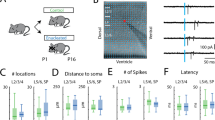Abstract
The X- and Y-cell pathways in cats form two functionally distinct, parallel systems from the retina through the lateral geniculate nucleus (LGN) to the visual cortex1–4. We recently used the technique of intraaxonal injection of horseradish peroxidase (HRP) to demonstrate major differences between X- and Y-cells in their retinogeniculate termination patterns5 (compare Figs 1a and 2a). Normally, axons of X-cells innervate geniculate lamina A or A1 (depending on the eye of origin) in narrow zones oriented perpendicular to the lamination. Some X-cells also terminate sparsely (that is, with few boutons) in the medial interlaminar nucleus (MIN), a subdivision of the LGN. Y-cell axons terminate either in laminae C and A (from the contralateral retina) or in lamina A1 (from the ipsilateral retina) in broad zones5,6, and most also terminate densely (with many boutons) in the MIN. We now report that cats raised with monocular lid suture develop abnormal retinogeniculate termination patterns. Many X-cell axons arising from the deprived eye have unusually broad terminal fields in lamina A or A1, and some also densely innervate the MIN. Many Y-cell axons from the deprived eye have dramatically shrunken or absent terminal fields in the A laminae and MIN. These changes constitute the most peripheral effects of monocular deprivation discovered so far, are consistent with previous reports of functional abnormalities among deprived geniculate neurones4,7,8 and suggest possible mechanisms by which the visual environment influences neuronal development.
Similar content being viewed by others
References
Rodieck, R. W. A. Rev. Neurosci. 2, 193–225 (1979).
Stone, J., Dreher, B. & Leventhal, A. Brain Res. Rev. 1, 345–394 (1979).
Lennie, P. Vision Res. 20, 561–594 (1980).
Sherman, S. M. & Spear, P. D. Physiol. Rev. 62, 738–855 (1982).
Sur, M. & Sherman, S. M. Science 218, 389–391 (1982).
Bowling, D. B. & Michael, C. R. Nature 286, 899–902 (1980).
Sherman, S. M., Hoffman, K.-P. & Stone, J. J. Neurophysiol. 35, 532–541 (1972).
Friedlander, M. J., Stanford, L. R. & Sherman, S. M. J. Neurosci. 2, 321–330 (1982).
Friedlander, M. J., Lin, C.-S., Stanford, L. R. & Sherman, S. M. J. Neurophysiol. 46, 80–129 (1981).
Hoffmann, K.-P., Stone, J. & Sherman, S. M. J. Neurophysiol. 35, 518–531 (1972).
Hochstein, S. & Shapley, R. M. J. Physiol., Lond. 262, 237–264 (1976).
Adams, J. C. Neuroscience 2, 141–145 (1977).
deOlmos, J. S. Expl Brain Res. 29, 541–551 (1977).
Boycott, B. B. & Wassle, H. J. Physiol., Lond. 240, 397–419 (1974).
Wassle, H., Peichl, L. & Boycott, B. B. Proc. R. Soc. B212, 157–175 (1981).
Wassle, H., Boycott, B. B. & Illing, R.-B. Proc. R. Soc. B212, 177–195 (1981).
Winfield, D. A. & Powell, T. P. S. Proc. R. Soc. B210, 197–210, 211–234 (1980).
Wilson, J. R., Friedlander, M. J. & Sherman, S. M. Soc. Neurosci. Abstr. 6, 583 (1980).
Daniels, J. D., Pettigrew, J. D. & Norman, J. L. J. Neurophysiol. 41, 1373–1393 (1978).
Torrealba, F., Guillery, R. W., Eysel, U., Policy, E. H. & Mason, C. A. J. Comp. Neurol. (in the press).
Purves, D. & Lichtman, J. R. Science 210, 153–157 (1980).
Rakic, P. Nature 261, 467–471 (1976).
Ivy, G. O. & Killackey, H. P. J. Neurosci. 2, 735–743 (1982).
Sherman, S. M. in Changing Concepts of the Nervous System (eds Morrison, A. R. & Strick, P. L.) 337–359 (Academic, New York, 1982).
Author information
Authors and Affiliations
Rights and permissions
About this article
Cite this article
Sur, M., Humphrey, A. & Sherman, S. Monocular deprivation affects X- and Y-cell retinogeniculate terminations in cats. Nature 300, 183–185 (1982). https://doi.org/10.1038/300183a0
Received:
Accepted:
Issue Date:
DOI: https://doi.org/10.1038/300183a0
- Springer Nature Limited
This article is cited by
-
The Dorsal Nucleus of the Lateral Geniculate Body: Anatomy, Histology, Ontogenesis
Neuroscience and Behavioral Physiology (2023)
-
Effects of Strabismus and Monocular Deprivation on the Sizes of Callosal Cells in Cortical Fields 17 and 18 in the Cat Brain
Neuroscience and Behavioral Physiology (2014)
-
Activity-dependent disruption of intersublaminar spaces and ABAKAN expression does not impact functional on and off organization in the ferret retinogeniculate system
Neural Development (2011)
-
Retinal ganglion cell dendritic development and its control
Molecular Neurobiology (1996)





